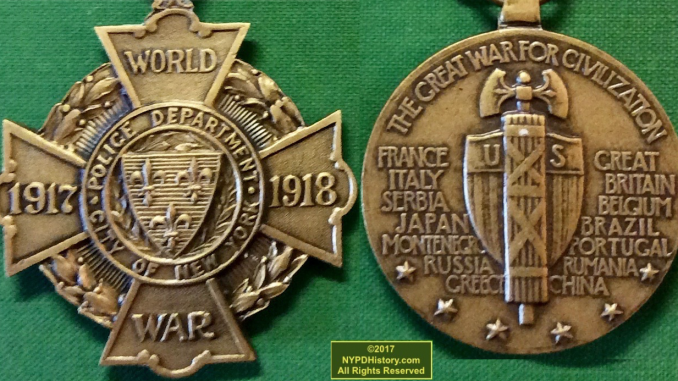
![]()
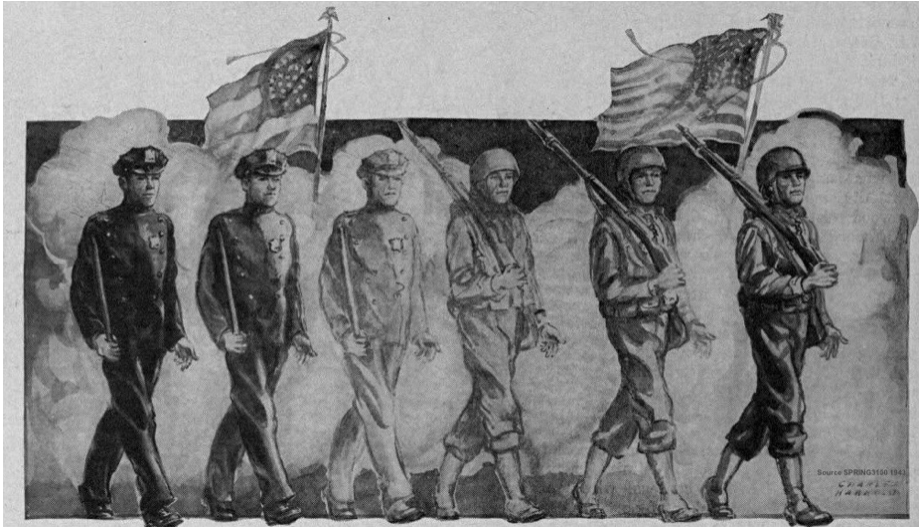
“Fidelis Usque Ad Mortem“or “Faithful Unto Death“
The Slogan of The Police Department of the City of New York
The following was released in 2016 & has been updated in May 2017 in recognition of National Peace Officers Memorial Day and the National Holiday of Memorial Day. This article is dedicated to the men and women who serve/served as law enforcement officers across this country; those who do/did “double-duty” in the military; and to those who sacrificed life and limb in the performance of their duties.
Introduction:
Police officers of the Police Department of the City of New York (PDNY/NYPD) have a long and strong history of military service. From the men of the Civil War era that left New York City’s Metropolitan Police Force to enlist or volunteer, to today’s missions around the world, hundreds of men and women have served in both capacities, many of whom sacrificed their lives. The department, its unions, as well as official and unofficial fraternal organizations, do an amazing job of never allowing the sacrifices made by their brothers to be forgotten.
This brief article will recount the story of one officer’s service and sacrifice; a man who served his adopted City of New York as a Patrolman and his country as a soldier. His story is more common than extraordinary; it exemplifies the unbridled sense of service that embodies the men and women of today’s police forces in New York City, and across this country.
William Edward Sheridan:
According to an article appearing in the News Eagle (Hawley, PA), on May 24, 2013, there are no living relatives to carry on the memory of William Edward Sheridan, who was one of ten children. How is it then, that his name and story will not be forgotten? Let us take a look at Patrolman Sheridan’s experience, service, and lasting legacy.
Patrolman (Ptl.) “Bill” Sheridan was born on October 20, 1893 in Hawley, Pennsylvania to parents James J. and Mary A. (nee Green Farrell) who were both born in America. According to the 1900 U.S. Census, seven children survived. James was employed as a Weaver in a silk mill. Bill had two brothers and four sisters and grew up in a private house, built in 1869, on Highland Street, near a bend in the Lackawaxen River.
In 1911, at age eighteen, Bill left Hawley to live in New York City and was appointed as a Special Patrolman. While a Special Patrolman, Sheridan resided at 1500 St. John’s Place, Brooklyn.
On October 22, 1917 (two days after his twenty-fourth birthday) Bill was appointed to the PDNY. After graduating the Police College (as the police academy was named at the time), Ptl. Sheridan, Shield 6817, was assigned to the 82nd Precinct (Butler St. Station House), Brooklyn. Sheridan resided at 1481 Dean St., Brooklyn while a Patrolman and at the time he went to war.
According to the Annual Report of the PDNY for 1918, Ptl. Sheridan received a “Commendation” for “an act of conspicuous bravery which left him with serious injuries, requiring hospitalization.” Another source revealed that Ptl. Sheridan was awarded a “medal for bravery” for the act, which proved “that he (was) ready to live up to the tradition of the undefeated army of blue – and was to die in the in the discharge of duty.” The details for the act are that he stopped a runaway horse and saved the lives of several children.
Captain Butler recommended Ptl. Sheridan for an Honorable Mention, which was approved by Police Commissioner Richard E. Enright. Ptl. Sheridan was inducted by the Honor Legion of the PDNY as an “Honor Legion man.” A copy of the Honorable Mention was later sent by PC Enright to Ptl. Sheridan in France.
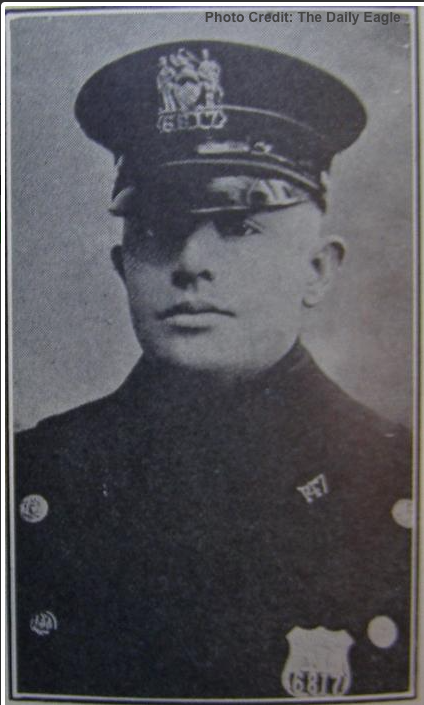
Service Beyond Service:
Like other police officers, Patrolman William E. Sheridan, Shield 6817, was exempt from the Draft, but on June 5, 1918 registered for military service, and took a leave of absence from the PDNY to join the United States Army. After deployment, Private Sheridan arrived in Europe on July 18, 1918 and trained in the “reciting and training” company that was the 19th Company, 152nd Depot Brigade. On July 24, 1918, Private Sheridan was Promoted to the rank of Corporal. Upon successfully completing training, Pvt. Sheridan was assigned to, and fought with, Company B, 79th Division, 313th Infantry of the American Expeditionary Forces (AEF). The 313th fought with other divisions in the Battles of Montfaucon, and the Meusse Argonne (Argonne Forest) which history has recorded as one of the most brutal, bloody, and fierce battles fought in the Great War and resulted in the war’s end.
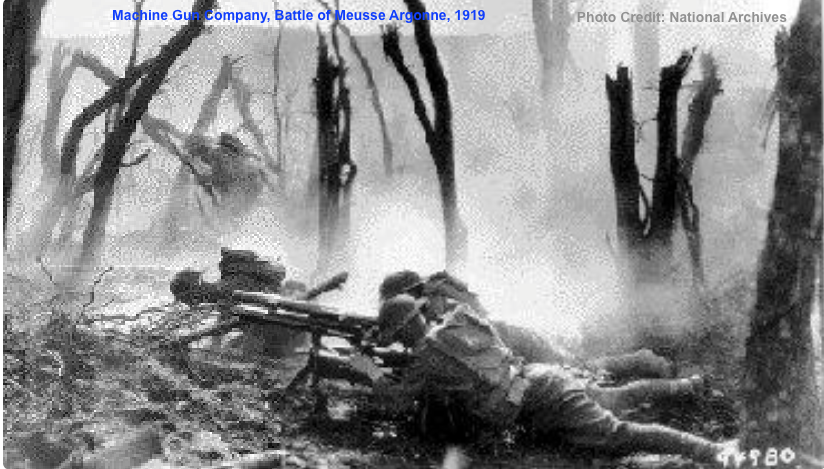
On October 1, 1918, during the battle of the Meusse Argonne, “Corporal ‘Bill’ Sheridan who rallied the remaining men and made a desperate charge against the Hun,” was less than three weeks shy of his twenty-fifth birthday, and just over one month from The Armistice, when he was killed by enemy machine-gun fire. Cpl. Sheridan was the only member of the PDNY Honor Legion to be killed in action during the Great War and according to an article published in the New York Sun, the ” first policeman to be killed in action in France.” Fidelis Usque Ad Mortem.
On December 17, 1919, the Honor Legion of the Police Department of the City of New York, led by Captain John H. Ayers, held a “Welcome Home” dinner for their members who served in the Great War, at the Elk’s Club, on South Oxford St., Brooklyn. According to a newspaper article published before the event “There will be one sad note to the otherwise happy and patriotic event. It will be a silent toast to one of the gallant members of the Honor Legion who lies in a hero’s grave in France. William E. Sheridan, of the Butler street station.” The article added that Ptl. Sheridan “was given a big send-off by the officers and men” of the precinct when he left to join the Army and that his “homecoming was anxiously awaited by his family and fellow bluecoats, but, almost within a month of the end of the great war, he fell while taking part in a charge.”
Corporal Sheridan’s body, initially buried amongst his comrades in France, was shipped back to the United States, arriving in his hometown, Hawley, on July 17, 1921. Upon learning of fellow Honor Legion member Ptl. Sheridan’s body’s arrival in the United States, Lieutenant Martin J. Regan, President of the Honor Legion, petitioned permission from Police Commissioner Richard E. Enright for a delegation of AEF Veteran PDNY officers to travel to, and participate in, the burial services for their fallen comrade. Quoting Lt. Regan, “Big-hearted and patriotic, Enright immediately issued an order granting the request” to allow officers to attend, all of whom were veterans of the same war,” however they were required to “take leave” to attend!
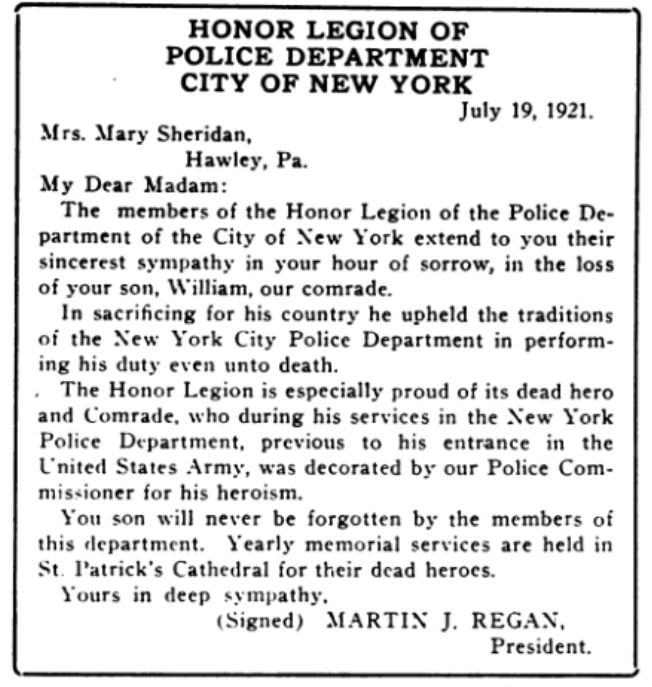
On July 20, 1921, Ptl./Corporal Sheridan’s remains were reinterred in Hawley, at Saint Philomena’s Cemetery (known today as Queen of Peace Church Cemetery). It was reported that the “Honor Legion and American Flags were carried side by side at the funeral of Sheridan, one of the ‘bravest of the brave’ who gave up his life for his country. He lived up to the slogan, Fidelis Usque Ad Mortem.”
This remembrance by Ptl. Sheridan’s PDNY comrades would not be the last, however, as it is the practice of the PDNY that these men and women are “Never Forgotten.
According to the Annual Report of the PDNY, eighteen other members of he department, along with Ptl. Sheridan, died in the service of their country in 1918.
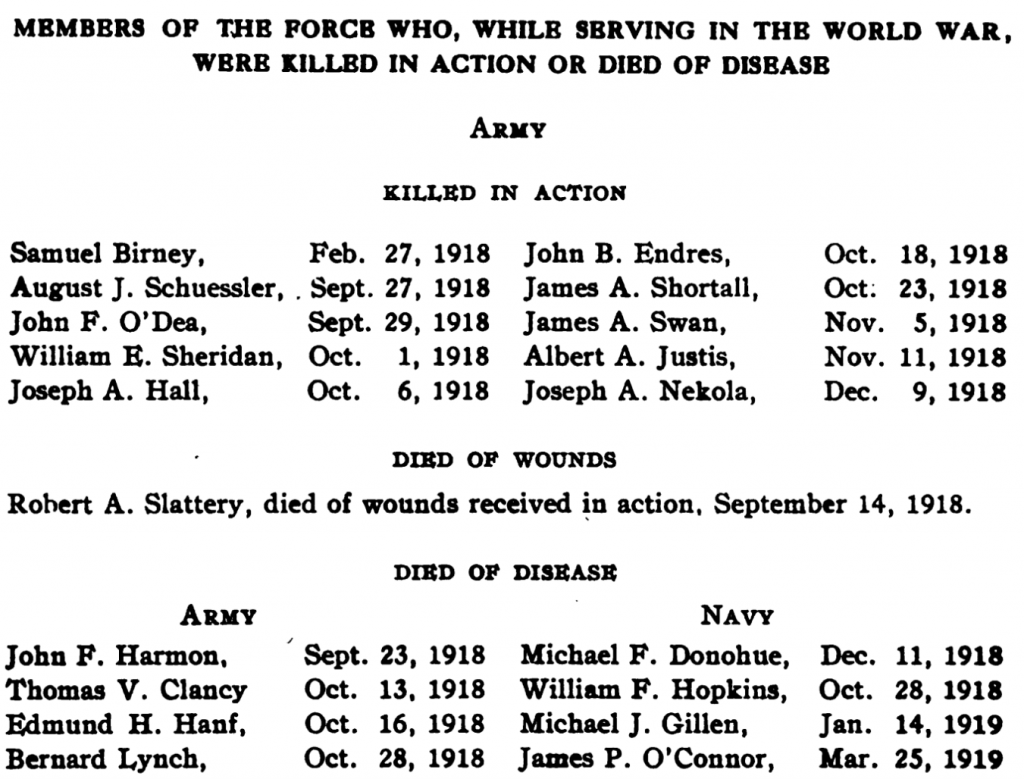
“Never Forgotten” – The PDNY/NYPD Never Forgets Those Who Sacrificed All
On June 20, 1922, at Police Headquarters, located at 240 Centre Street, Manhattan, a “World War Memorial Tablet” bearing the names of 827 members of the department who served in the Great War was unveiled in a grand manner. A parade beginning downtown at historic Fraunces Tavern, made its way up Broadway to 240 Centre Street, where a grandiose police headquarters, built in 1909, awaited their arrival. Immediately upon entering headquarters, visitors saw a large central staircase “leading to the tablet, (which) was heaped with floral pieces sent by various military and police organizations and individuals.”
After an invocation, a bugler sounded “Taps.” Military Honor Guards representing all of the branches of service presented The Colors. There were musical tributes, and addresses from dignitaries and military officers. The large tablet, made of bronze, “in the form of a Maltese cross” was set between large stained glass windows which must have cast beautiful hues on it when the sun came through the windows. The Annual Report mentioned that although the “police force of New York City was, in effect, an important arm of the war forces, and its members should be exempt…nevertheless, about 8 per cent of the strength of the force elected to enlist.” Detailed instructions were written into the Annual Report describing dedication ceremony of the “Memorial Tablet.”
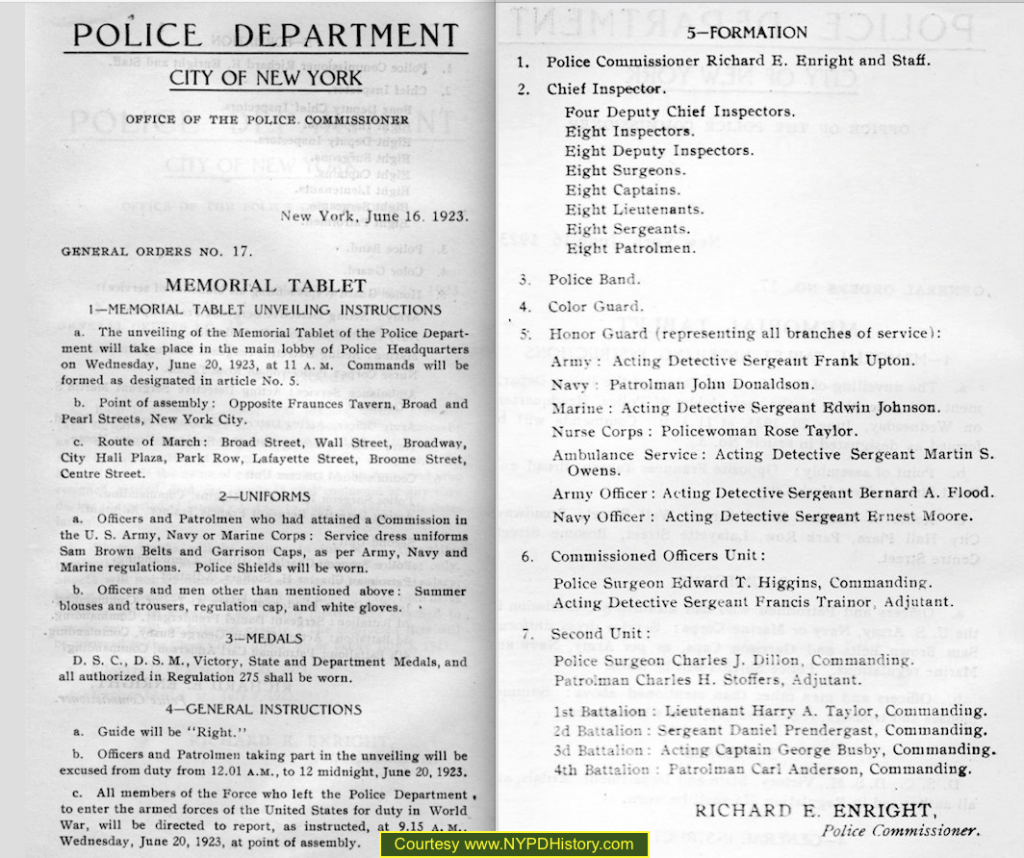
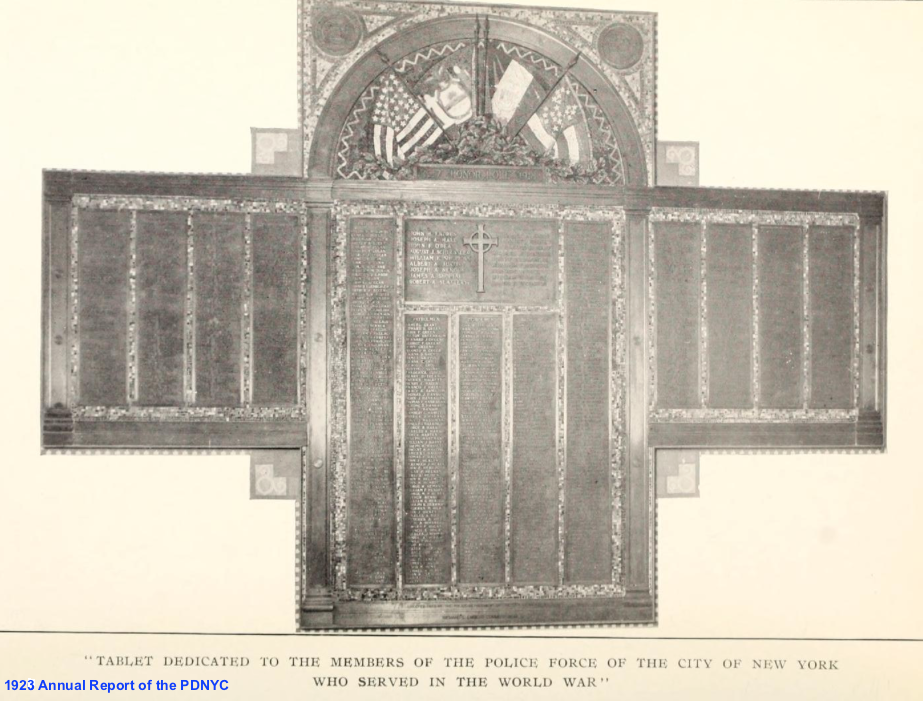
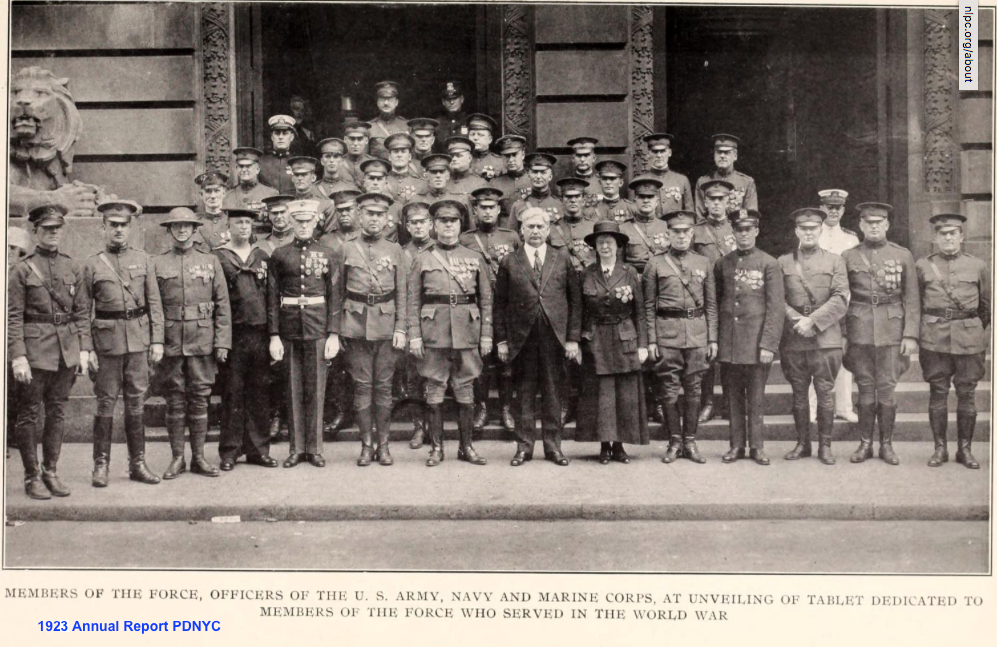
According to an architectural journal, “This monumental, domed structure, constrained on a triangular lot, was designed ‘to impress both the officer and prisoner with the majesty of the law.’ The interior of the building housed both the functional and the imposing. The marble-clad reception area was palatial. In the basement was a gymnasium and a firing range. On the top floor was an observation deck.”
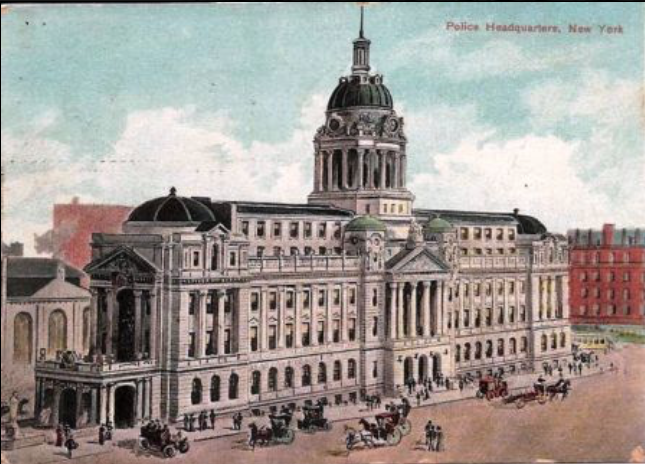
Ten years later, on May 28, 1933, The Brooklyn Daily Eagle, reported that “the Police Department honored its dead who lost their lives on the battlefields of France and on the streets of this city, at Police Headquarters beside the bronze plaques bearing the names of those who died in service.”
Taking part in the ceremony was the department’s Honor Legion as well as members of the “William E. Sheridan Police Post of the American Legion.” The same newspaper, on November 5, 1932, reported under the headline “3,000 Policemen And Friends Attend Sheridan Post Ball; Legion Unit Affair Pays Honor to Policeman Who was killed During War” that Sheridan’s namesake Post, number 1059, held its first annual entertainment and dance which was attended by Police Commissioner Mulroney and other officials and dignitaries. Subsequent articles reported the many, varied, activities of the American Legion Post in the honor of this great man including participation in parades, PDNY ceremonies and parades, civic parades, etc.
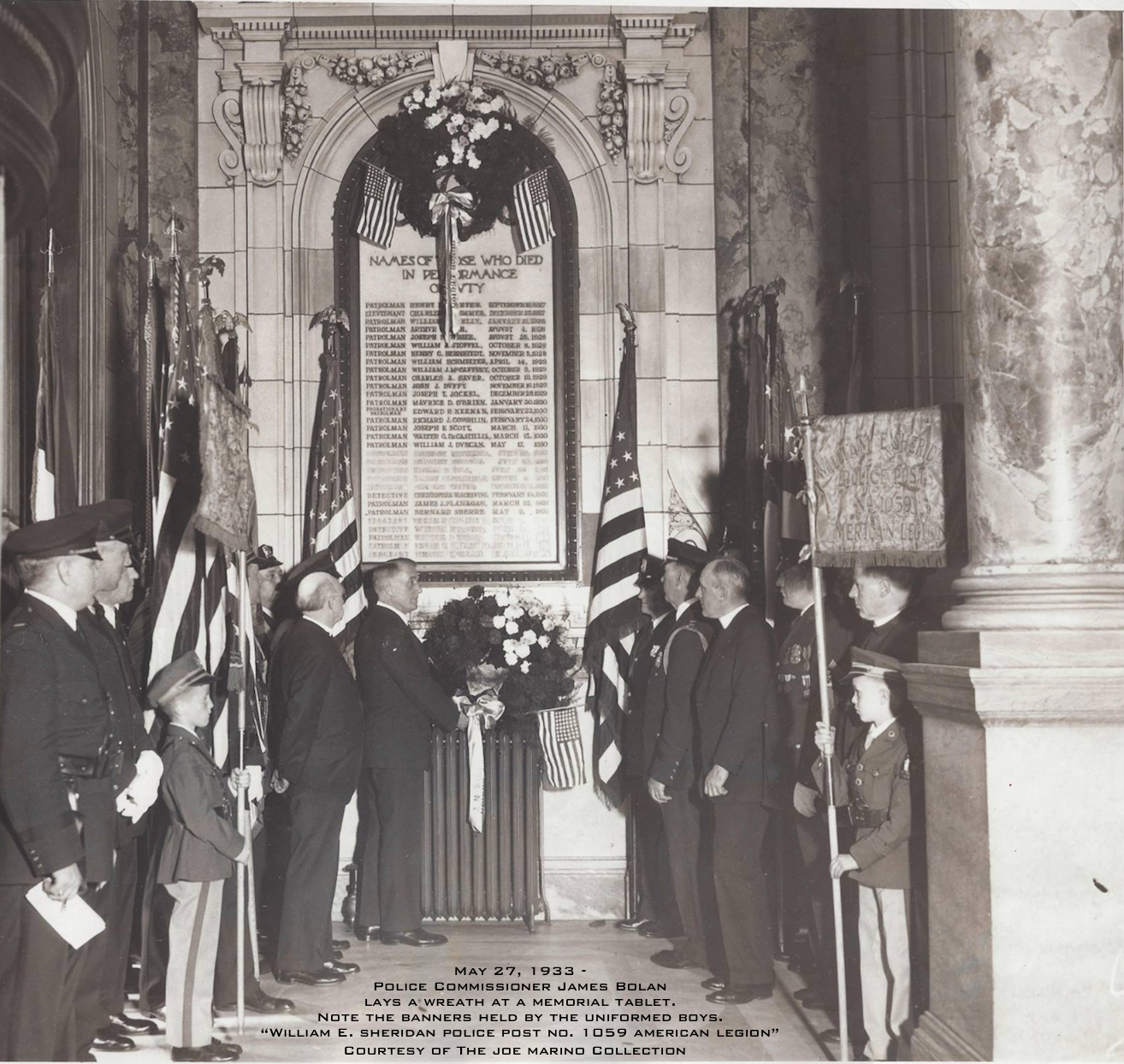
Another type of remembrance was recorded in the official records of New York City as well as in the press. On July 15, 1934, New York City Mayor Fiorello LaGuardia, via live radio broadcast, simultaneously dedicated several new parks across the city. These parks were referred to as “War Memorial Parks” and are easily recognizable throughout the city by the mast-style flagpole, style of construction, and signage.
One park, located at the address 80-100 Grand Street, (between Wyeth & South 1st St.) Brooklyn, was dedicated/named the “William E. Sheridan Playground.” Members of the Sheridan American Legion were present. The park is located in today’s 90th Police Precinct. (Note: A photograph of the lot, prior to construction of the playground, appears below at the end of this article.)
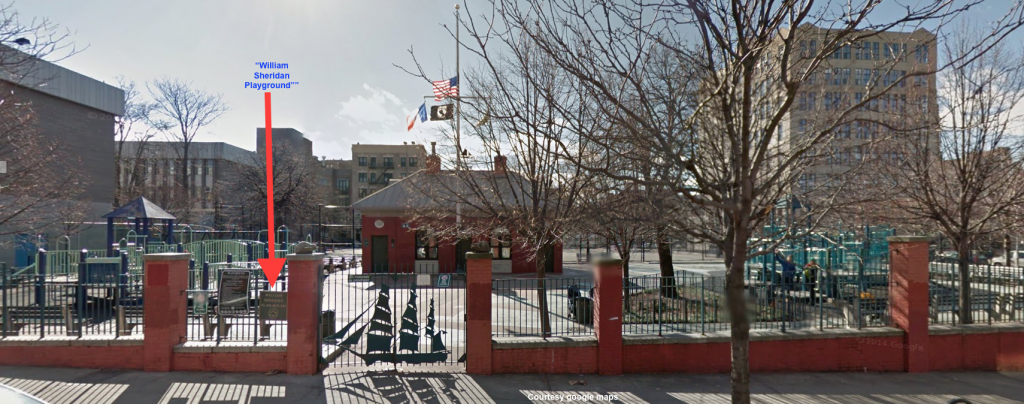
Beginning after the formation of the American Legion Post, through approximately 1941, members of Sheridan Post 1059 made a “pilgrimage” to his gravesite in Hawley, PA and participated in related tributes. In 1945, after the end of World War II, the Sheridan Post led the Macy’s Thanksgiving Day Parade in New York City! As of 2013, the Hawley News Eagle reported, that there were eighteen members of the Sheridan Post. The author contacted the Sheridan Post’s executive officer who stated that he was delighted to learn that the memory of their beloved .
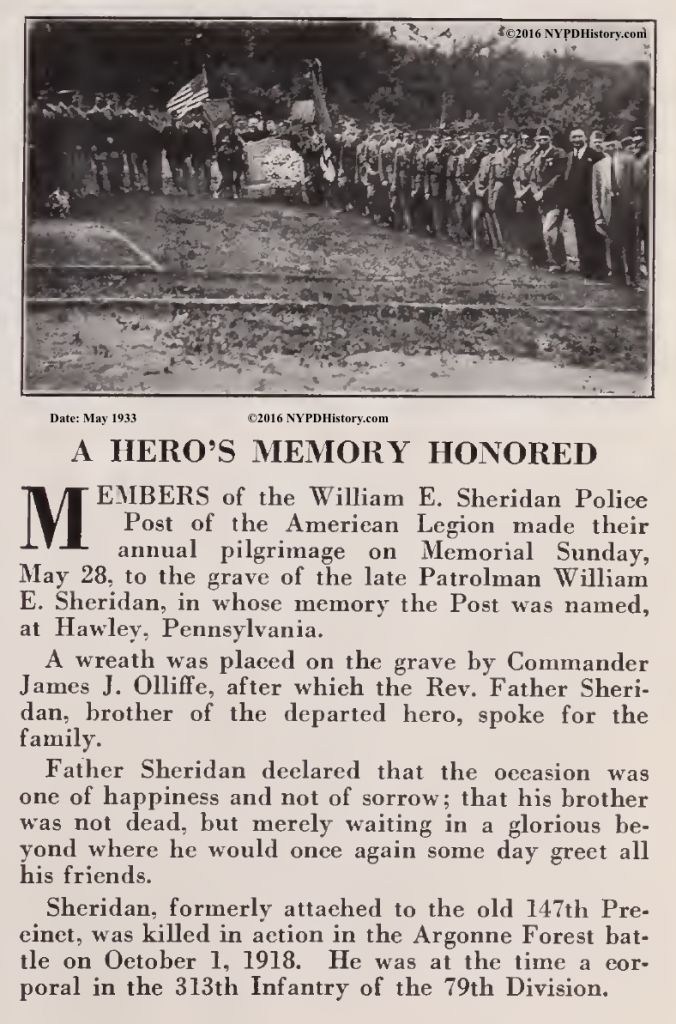
May 28, 1933 , Hawley, PA – Fifteen years after his death, the American Legion Post named in his honor, paid tribute at his burial site.
As a member of the PDNY who served in the AEF During “the Great War,” Patrolman William Edward Sheridan would have been entitled to wear both of the medals below. the first is a PDNY authorized World War Service medal. The second is a U.S. Military Medal knows as a Victory Medal. As a veteran of two named battles, two small bars bearing the names of the battles (Montfaucon and Meusse Argonne) would have been affixed to the ribbon.

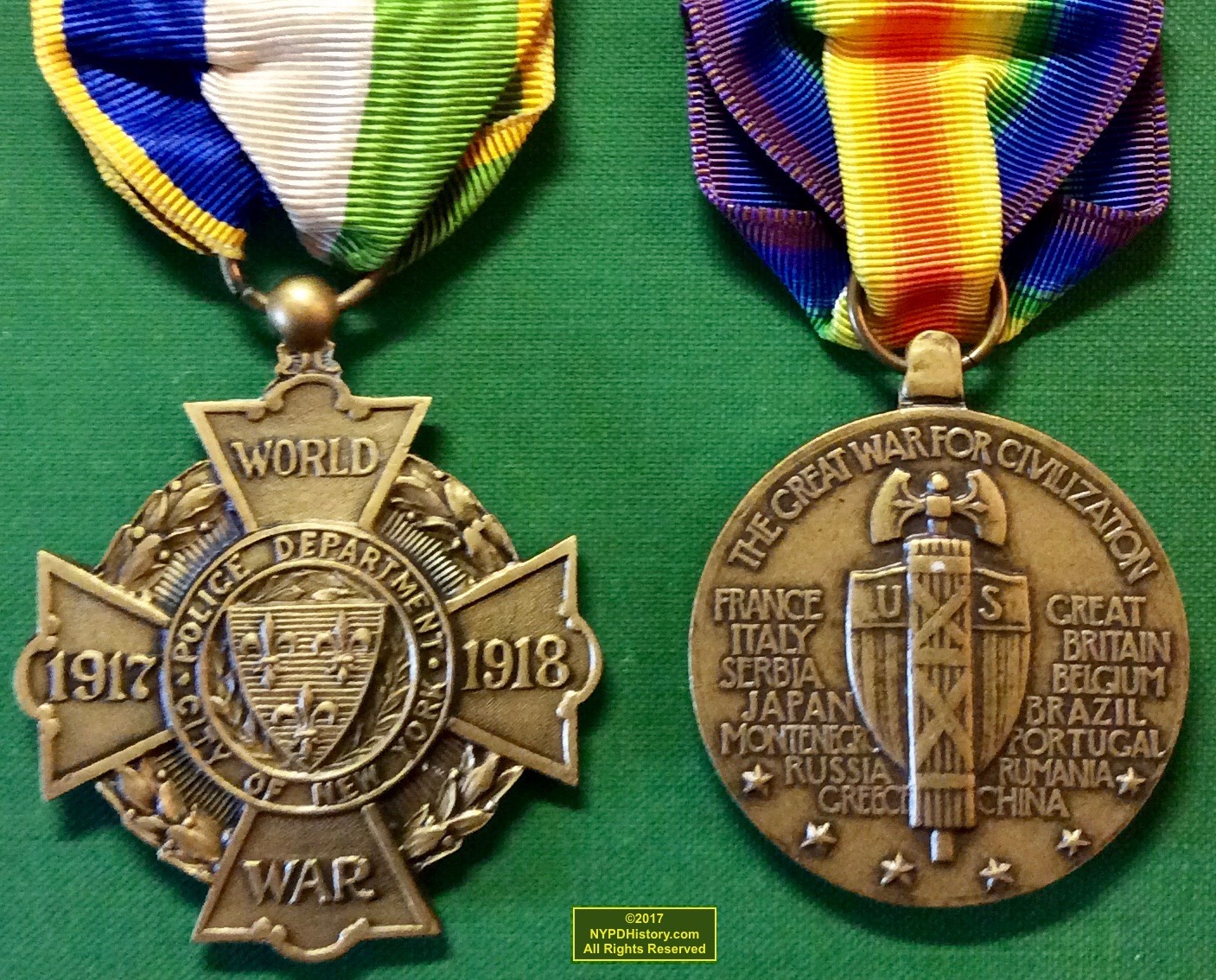
Summary:
Patrolman William E. Sheridan answered the call for the service of his nation, lost his life for his country on foreign soil, was buried on foreign soil. When his remains returned home, the news caught the attention of his police comrades who recognized the importance of taking care of a brother after death. Consistent with the practice of never forgetting those who sacrificed all, Ptl. Sheridan’s memory remains alive vis-à-vis a playground/city park and American Legion Post.
Additional Photos:
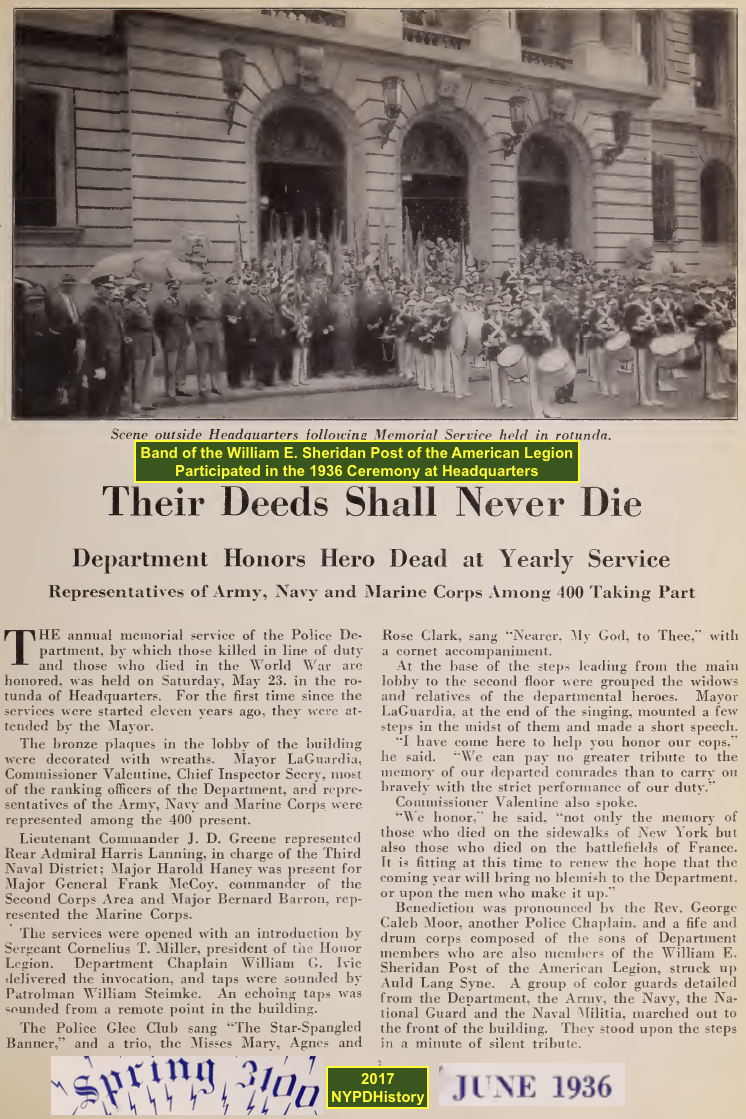
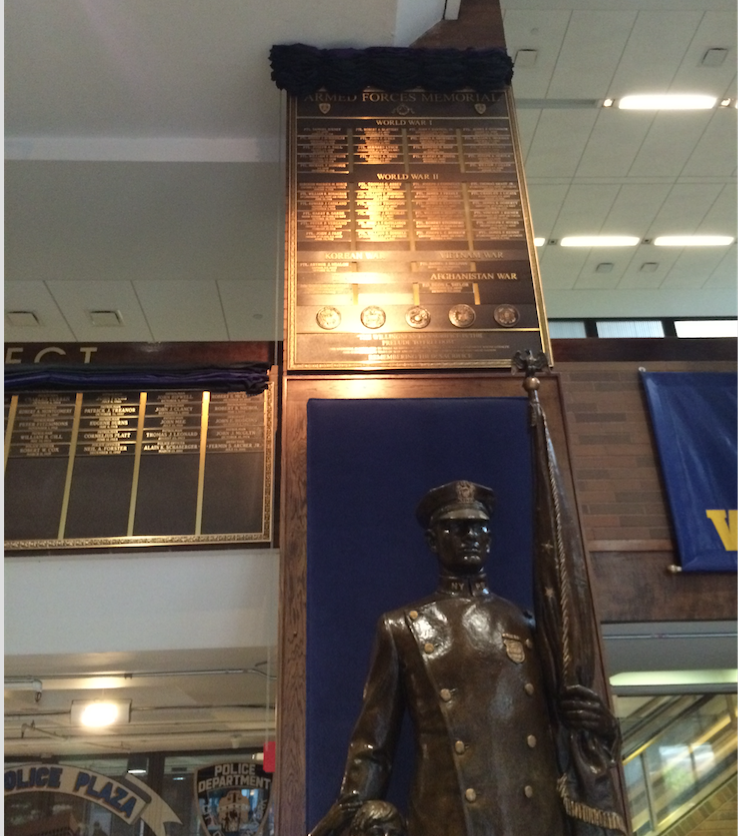
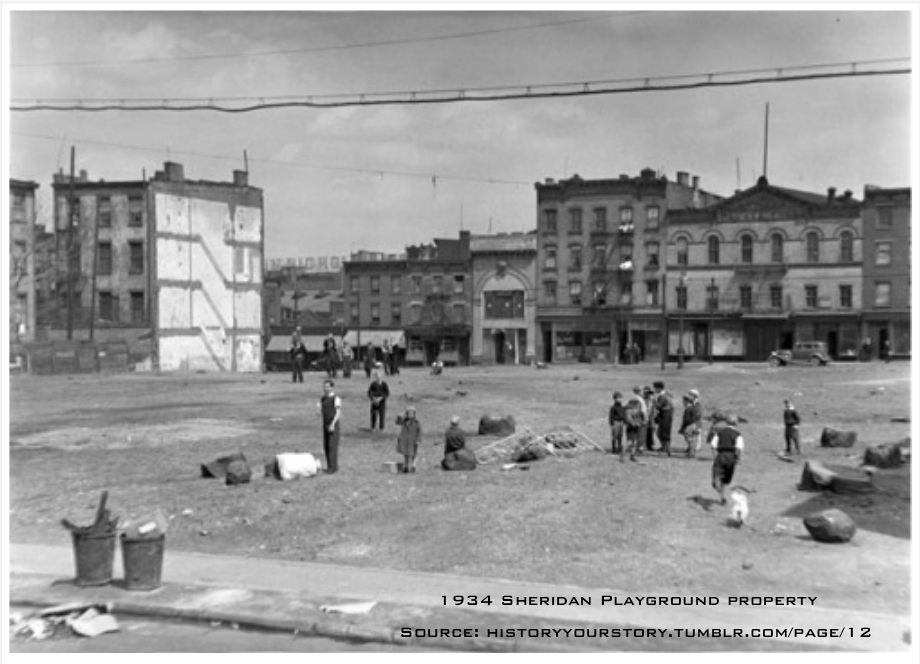
1934 – Land dedicated for the Sheridan War Memorial Playground![]()
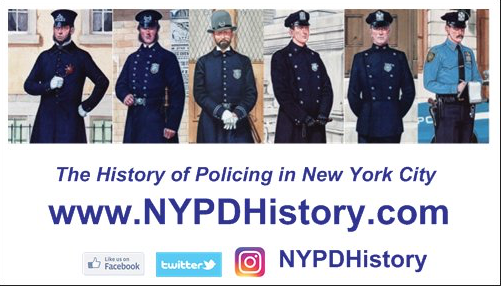

Leave a Reply
You must be logged in to post a comment.